Opening in New York: Harmony Hammond: Crossings

Harmony Hammond: Crossings, installation view, Alexander Gray Associates, New York (2020). Photo courtesy of the artist.
Harmony Hammond: Crossings
Exhibition Dates: November 12, 2020 – January 16, 2021.
Alexander Gray Associates, New York presents Crossings, its fourth exhibition of work by Harmony Hammond (b.1944). Featuring paintings dating from 2018-2020, the show’s large-scale canvases boast built-up surfaces that further refine the artist’s interest in “material engagement,” expanding and subverting modernist abstraction to bring social and political content into the nonrepresentational realm.
In Chenille #7 (2018), fraying pieces of coarse burlap and grommets are embedded in Hammond’s signature layers of thick paint. Appearing at first glance to be a monochrome, up close, underlying colors are visible through cracks and peek out from flaps in the painting’s sculptural surface. Patterns created by the work’s raised grommets recall the soft, cozy texture and domestic warmth of white tufted chenille bedspreads. At the same time, reds, browns, and golds assert themselves from underneath the surface, oozing, discharging, and staining their surroundings to draw attention to what has been muffled, obscured, and covered over. In this way, the painting alludes to political threats and social unrest — marginalization and suppression — and lays claim to the physical vestiges of resistance and survival.
Meanwhile, Hammond’s series of Bandaged Grids transform strips of canvas into bandages that stanch paint leaking from grommeted holes. Recalling the artist’s use of found fabric scraps in the 1970s, the seeping grommets and red-stained cloth of Bandaged Grid #9 (2020) refute the non-objective nature of the modernist grid, interjecting a corporal narrative and violent edge into its strict formalism. As the artist notes, “A bandage always implies a wound. A bandaged grid implies a disruption of utopian egalitarian order—but also the possibility of holding together, of healing.”
Building on the conceptual framework that informs Hammond’s Bandaged Grids, her series of Bandaged Quilts use paint and other materials as a metaphor for the body. Featuring lengths of burlap and canvas arranged in quilt-like patterns, Double Bandaged Quilt #1 (Horizontal) (2019), Double Bandaged Quilt #3 (Vertical) (2020), and Fringe (2020) subvert the (male) legacy of Minimalist monochromatic painting, reclaiming these abstract compositions through the vernacular of (female) craft traditions.
Similarly evocative, Black Cross (2019–2020) and Red Cross (2019—2020) feature wide swaths of rough burlap superimposed like giant cross-shaped bandages on white fields of grommets. “They are crosses and not crosses,” Hammond muses. “I began these paintings during the summer of 2019. What reads as crosses weren’t initially meant as crosses, but rather as Xs marking the spot, as plus signs and intersections. And yet, I have to admit, that they are crosses. There are many kinds of crosses and many kinds of crossings.” Despite the scale and muscular materiality of the Cross Paintings, as a sign, the cross is indeterminate; its form references diverse cultural associations, including religious iconography, emblems of medical and humanitarian aid, and the modernist art historical canon.
A crossroads for meaning — where the metaphorical and formal meet and are transmuted — Hammond’s Cross Paintings and other recent works ultimately invite multiple readings rooted in the primacy of the canvas as a stand-in for the body. Presenting her paintings as sites where paint is transfigured into skin, the artist constructs surfaces that simultaneously express trauma and recovery. Recuperative paintings for this moment — wounded, yet protective—Hammond’s works embody vulnerability, strength, and defiance to resonate in a time of radical social change.
About the Artist
Harmony Hammond has exhibited nationally and internationally. In 2019, The Aldrich Contemporary Art Museum in Ridgefield, CT presented a fifty-year survey exhibition of her work, which traveled to the Sarasota Museum of Art, FL in 2020. Other institutions that have featured her work include: Whitney Museum of American Art, NY (2020); Museum of Contemporary Art Chicago, IL (2019); Des Moines Art Center, IA (2019); Brooklyn Museum, NY (2018, 1985); Museum of the City of New York, NY (2016); Museum Moderner Kunst Stiftung, Ludwig, Vienna, Austria (2016); Rose Art Museum, Waltham, MA (2015); National Museum of Women in the Arts, Washington, DC (2011); MoMA PS1, Queens, NY (2008); Vancouver Art Gallery, Canada (2008); and Museo de Arte Contemporaneo Internacional Rufino Tamayo, Mexico City, Mexico (2007), among others. Hammond’s work is in the permanent collections of the Art Institute of Chicago, IL; Brooklyn Museum, NY; Metropolitan Museum of Art, New York, NY; Minneapolis Institute of Arts, Minneapolis, MN; The Museum of Modern Art, New York, NY; National Museum of Women in the Arts, Washington, DC; New Mexico Museum of Art, Santa Fe, NM; Phoenix Art Museum, AZ; Wadsworth Atheneum, Hartford, CT; Walker Art Center, Minneapolis, MN; and Whitney Museum of American Art, New York, NY, among others. Her archive is in the permanent collection of the Getty Research Institute, Los Angeles, CA. She has received fellowships from the John Simon Guggenheim, Joan Mitchell, Pollock–Krasner, Esther and Adolph Gottlieb, and Art Matters Foundations, as well as the New York State Council on the Arts and the National Endowment for the Arts. Hammond’s book, Wrappings: Essays on Feminism, Art and the Martial Arts (TSL Press, 1984), is a foundational publication on 1970s feminist art. Her groundbreaking book Lesbian Art in America: A Contemporary History (Rizzoli, 2000) received a Lambda Literary Award and remains the primary text on the subject. In 2013, Hammond was honored with The College Art Association Distinguished Feminist Award. She received both the College Art Association’s Women’s Caucus for Art Lifetime Achievement Award and Anonymous was a Woman Award in 2014.